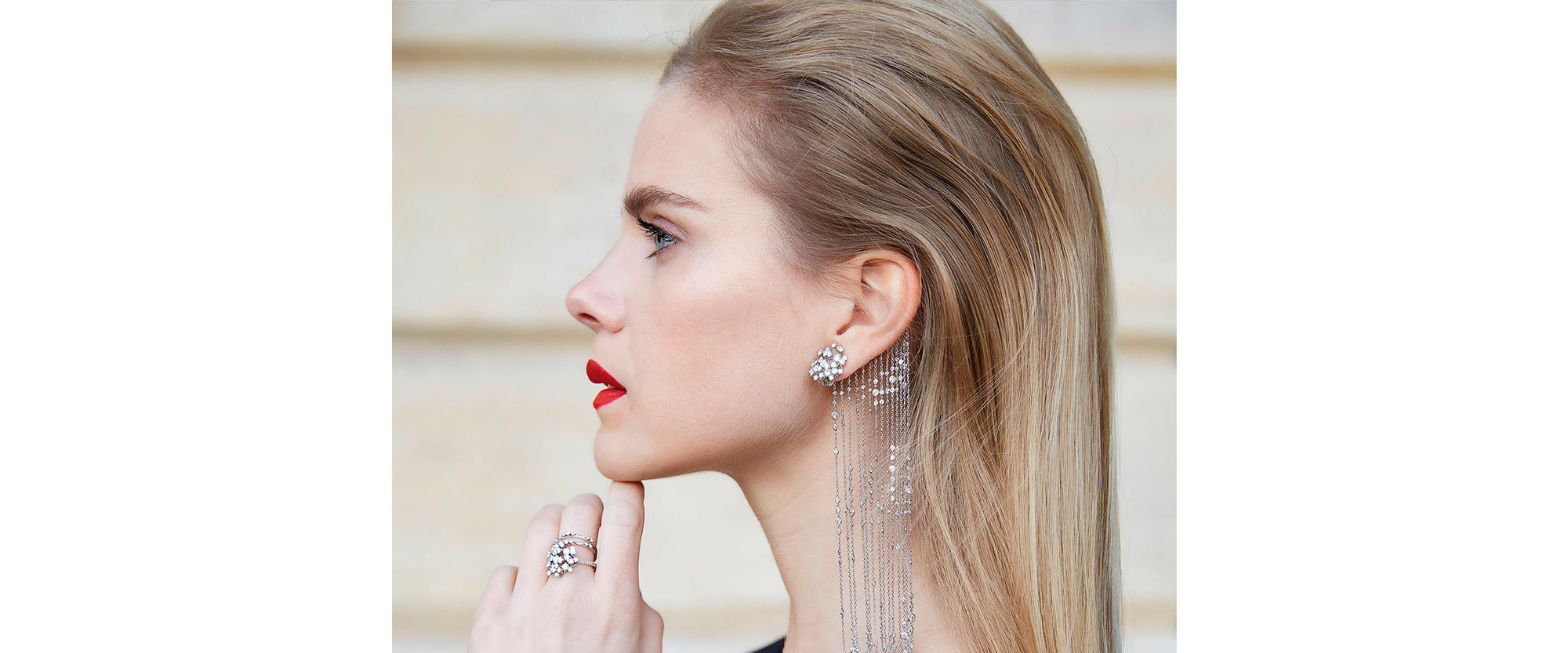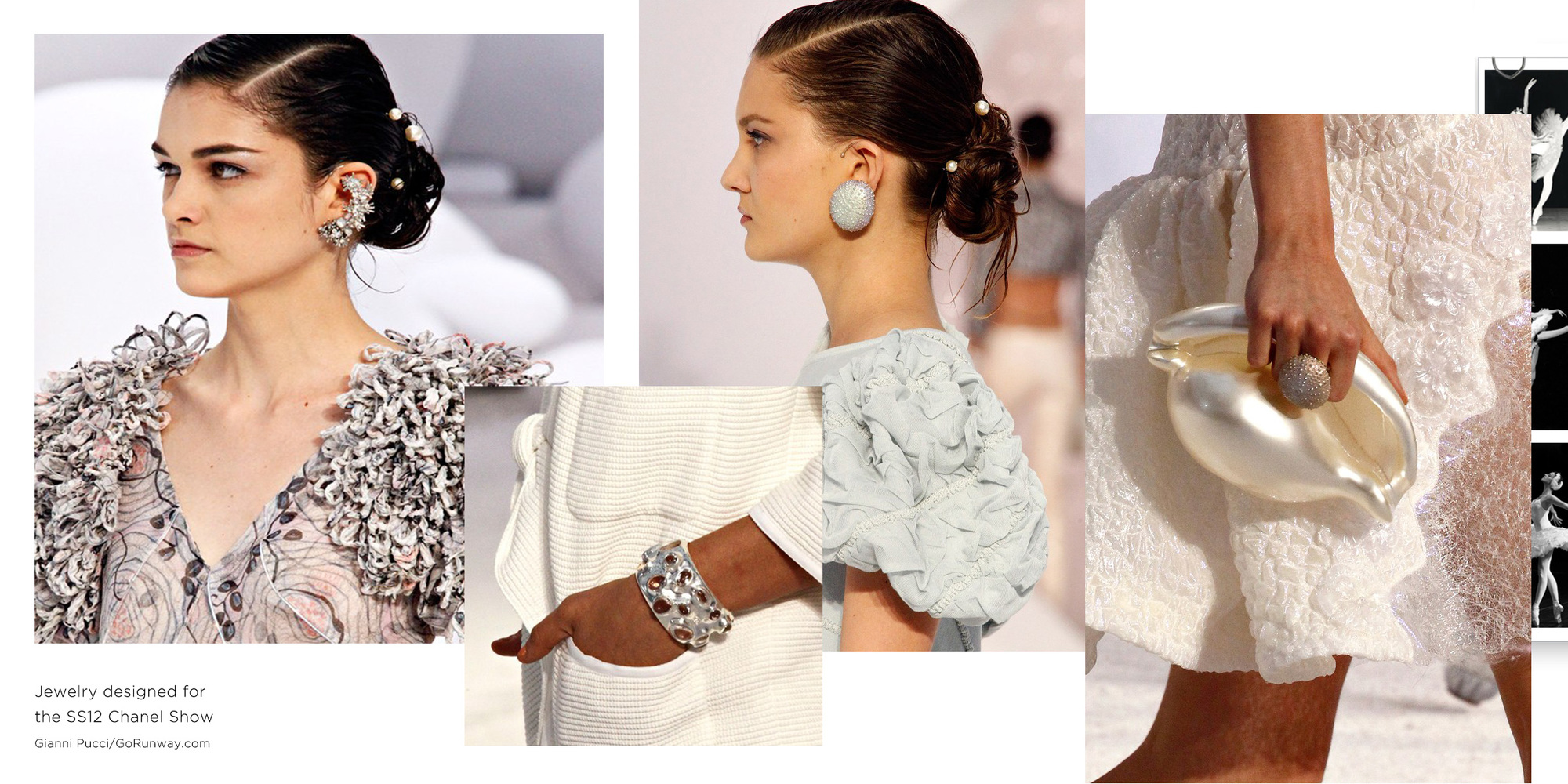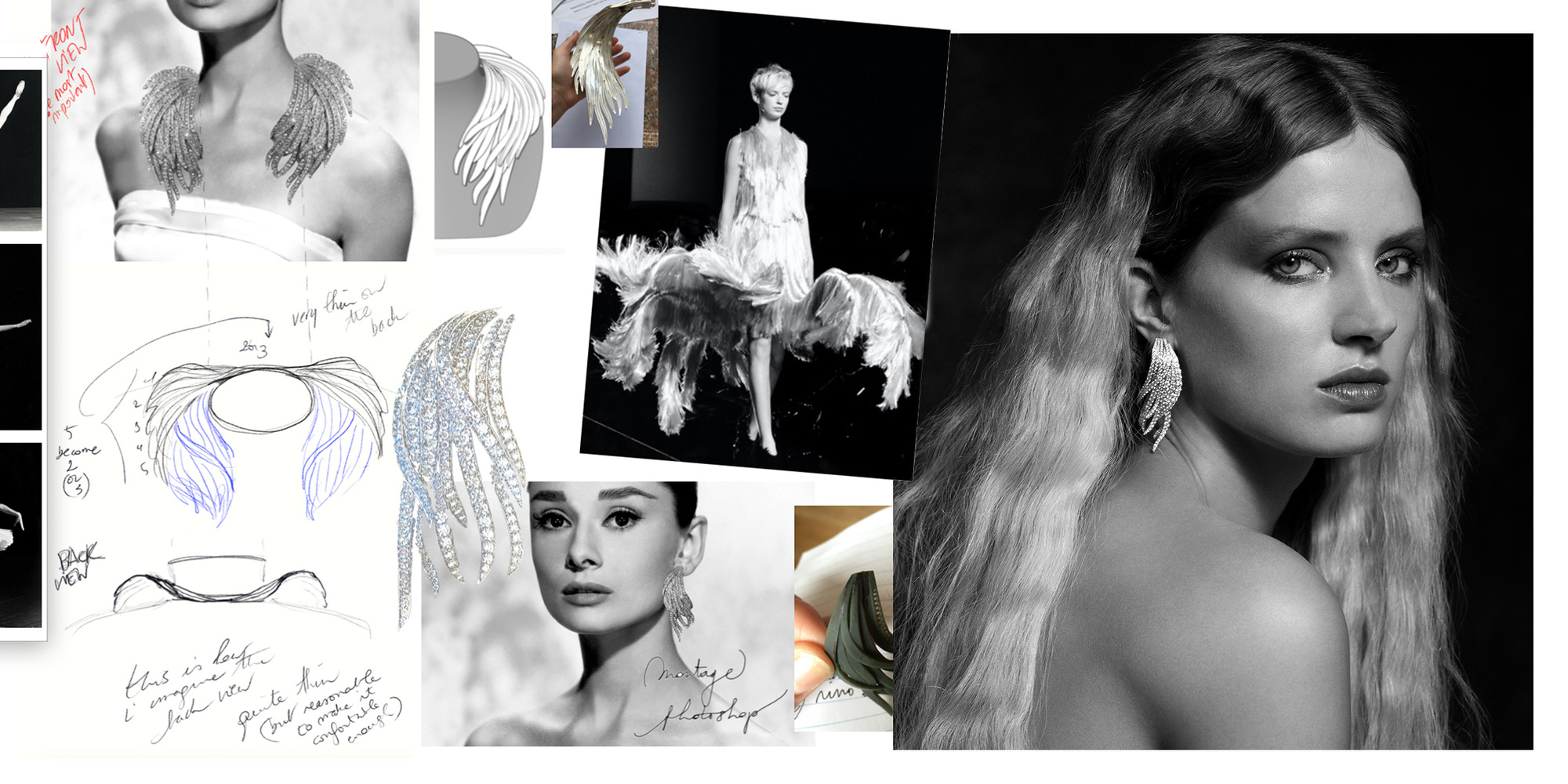
IN THE FRAME:
TATIANA
VERSTRAETEN
A protégé of Karl Lagerfeld, the Paris-based jeweler
A protégé of Karl Lagerfeld, the Paris-based jeweler
is finally breaking out on her own.
When Tatiana Verstraeten introduced herself to the world, it was via an exclusive story in the July '18 issue of British Vogue. It was the kind of coming out an emerging talent dreams of. And while it may have looked from the outside as though she had just burst onto the scene, that splashy debut was actually the result of years of hard work and a combination of carefully crafted experiences that she knew, with time, would lead her exactly where they ultimately did—to the epicenter of the fashion world.
After acquiring a Master’s in Business Management and Finance, Tatiana got her start in the industry by helping young designers build viable businesses (Maison Michel and Anthony Vaccarello among them). Add to that the years she spent honing her craft at Chanel—under the tutelage of Karl Lagerfeld, no less—and the result is a rare balance of business savvy and unparalleled taste.
Read on to find out how she managed to land such coveted positions—and the most important lessons (and techniques) she learned along the way. —Rachel Hodin
On "3-D" design…
When I’m making a piece of jewelry, the first step is to sketch the design. In order to make the actual piece, you need a wax version of it—the wax then creates the mold, as well as a casting for another mold, which is finally filled with gold to create the actual piece. You can either sculpt a wax version of it, or you work with a 3-D designer to create a digital rendition of the design through coding, and then you print the digital image in wax.
When I’m making a piece of jewelry, the first step is to sketch the design. In order to make the actual piece, you need a wax version of it—the wax then creates the mold, as well as a casting for another mold, which is finally filled with gold to create the actual piece. You can either sculpt a wax version of it, or you work with a 3-D designer to create a digital rendition of the design through coding, and then you print the digital image in wax.
On doing as much as possible herself…
I've started mixing my own enamel so I can control the color myself. It’s like painting. It’s also super hard to communicate the specific color you’re looking for to someone else, so I figured why don't I just learn to do this myself? I don’t use any color base. Instead, I take transparent enamel and then mix pigment in, which means I’m totally free to do any color—and my colors therefore don't exist anywhere else.
I've started mixing my own enamel so I can control the color myself. It’s like painting. It’s also super hard to communicate the specific color you’re looking for to someone else, so I figured why don't I just learn to do this myself? I don’t use any color base. Instead, I take transparent enamel and then mix pigment in, which means I’m totally free to do any color—and my colors therefore don't exist anywhere else.
On who’s wearing her designs…
[French actresses] Isabelle Huppert and Juliette Binoche. Also Naomi Campbell. I like that Emma Watson was the first one to wear my pieces as she’s a UN woman—I want more Unicef ambassadresses to wear my designs (Gigi Hadid, for example, and Angelina Jolie). I actually would love to collaborate with Unicef. I’m very concerned about violence on women in the world and support what Unicef does to educate everybody about those problems.
[French actresses] Isabelle Huppert and Juliette Binoche. Also Naomi Campbell. I like that Emma Watson was the first one to wear my pieces as she’s a UN woman—I want more Unicef ambassadresses to wear my designs (Gigi Hadid, for example, and Angelina Jolie). I actually would love to collaborate with Unicef. I’m very concerned about violence on women in the world and support what Unicef does to educate everybody about those problems.
On her style icons…
Grace Kelly, Natalia Vodianova, Carolyn Bessette-Kennedy and Audrey Hepburn.
Grace Kelly, Natalia Vodianova, Carolyn Bessette-Kennedy and Audrey Hepburn.
On her dream client…
Beyoncé? [laughs] She’s a strong one, she’s a queen. I mean she’s just very inspiring in general—as a mother, as an artist, as a woman. We need more Beyoncés to run the world. But also Sharon Stone, Salma Hayek, Amal Clooney, Zoë Kravitz, Cara Delevingne and Adwoa Aboah.
Beyoncé? [laughs] She’s a strong one, she’s a queen. I mean she’s just very inspiring in general—as a mother, as an artist, as a woman. We need more Beyoncés to run the world. But also Sharon Stone, Salma Hayek, Amal Clooney, Zoë Kravitz, Cara Delevingne and Adwoa Aboah.
On what makes her unique...
As someone who didn’t go to fashion school, I believe I maybe have a refreshing naiveté, creatively speaking. I keep myself inspired by looking to art forms outside of fashion and jewelry. Primarily, my passions lie outside of jewelry, so I try to bring them into my work.
As someone who didn’t go to fashion school, I believe I maybe have a refreshing naiveté, creatively speaking. I keep myself inspired by looking to art forms outside of fashion and jewelry. Primarily, my passions lie outside of jewelry, so I try to bring them into my work.
On why Beyoncé inspires her…
She plays an active role in every part of her projects—the dancing, the singing, the choreography, the art direction—and has a strong personal style. She’s also trained a lot to get to where she is today. Like a professional athlete, she knows what it means to work hard, to have discipline and perseverance, and she knows that sometimes you need to make sacrifices to reach your goals. She inspires me to be a warrior in my own field.
She plays an active role in every part of her projects—the dancing, the singing, the choreography, the art direction—and has a strong personal style. She’s also trained a lot to get to where she is today. Like a professional athlete, she knows what it means to work hard, to have discipline and perseverance, and she knows that sometimes you need to make sacrifices to reach your goals. She inspires me to be a warrior in my own field.
On the most memorable designs she worked on at Chanel…
My favorite collection was probably Spring / Summer ’12, inspired by the ocean ground. We used a lot of pearls for the jewelry—destroyed, baroque pearls as opposed to round pearls. It’s common in high jewelry to design for a particular material or stone. Personally, I like to imagine the volume of the piece first, and then bring even more life to that volume with the positioning of the stones.
My favorite collection was probably Spring / Summer ’12, inspired by the ocean ground. We used a lot of pearls for the jewelry—destroyed, baroque pearls as opposed to round pearls. It’s common in high jewelry to design for a particular material or stone. Personally, I like to imagine the volume of the piece first, and then bring even more life to that volume with the positioning of the stones.
On how she met British Vogue editor Edward Enninful…
I was inspired by Edward's new vision for Vogue. He’s twisting classic ideas about fashion in a way that feels fresh: He’s really holding a mirror up to society, spotlighting all of its new strengths and concerns. I was advised by a friend to meet him. He loved the collection, and offered to cover it with an exclusive story. I had the honor of being featured in two Vogue issues in a row, one in July 2018 and one in August 2018. The first was about my pieces and the second was about me. A few months later I launched officially at Paris Couture Week.
I was inspired by Edward's new vision for Vogue. He’s twisting classic ideas about fashion in a way that feels fresh: He’s really holding a mirror up to society, spotlighting all of its new strengths and concerns. I was advised by a friend to meet him. He loved the collection, and offered to cover it with an exclusive story. I had the honor of being featured in two Vogue issues in a row, one in July 2018 and one in August 2018. The first was about my pieces and the second was about me. A few months later I launched officially at Paris Couture Week.
On her upbringing…
I come from a family where everybody is a doctor or engineer but we also took the arts very seriously. My mom is a pediatrician, but also an accomplished artist. She has a little atelier in the garden where she sculpts and paints. However, she never exhibited or tried to sell her work—she does it purely for the pleasure of Art and because it’s relaxing to her. In this way, it never really crossed my mind that art could be my profession.
I come from a family where everybody is a doctor or engineer but we also took the arts very seriously. My mom is a pediatrician, but also an accomplished artist. She has a little atelier in the garden where she sculpts and paints. However, she never exhibited or tried to sell her work—she does it purely for the pleasure of Art and because it’s relaxing to her. In this way, it never really crossed my mind that art could be my profession.
How she transitioned into fashion...
While I was studying, my then-boyfriend was trying to pursue a career as an extreme sports athlete and I ended up helping him make a business out of his passion by finding him sponsors, etc. It was a wonderful experience. It awakened the idea in me to work in a similar way with young artists who had talent but struggle with money or business knowledge. That’s how I met Anthony Vaccarello—in Paris at the very beginning of his career. He needed help and I was excited by his work, so it was a great match. I helped him with everything including modeling, sales, structuring his ideas and his business.
While I was studying, my then-boyfriend was trying to pursue a career as an extreme sports athlete and I ended up helping him make a business out of his passion by finding him sponsors, etc. It was a wonderful experience. It awakened the idea in me to work in a similar way with young artists who had talent but struggle with money or business knowledge. That’s how I met Anthony Vaccarello—in Paris at the very beginning of his career. He needed help and I was excited by his work, so it was a great match. I helped him with everything including modeling, sales, structuring his ideas and his business.
On how she got to Chanel...
By hanging out with more and more people in the fashion industry and their creative teams, I became interested in working on the creative side of things, so someone recommended me as a jewelry and hat designer for Chanel. That’s where I learned everything, on Karl’s team. I had a good creative instinct and was resourceful. They liked my taste and drawings, but technically, [before working for Chanel], I hadn’t had any experience designing jewelry—especially for a big company. I had to learn on the spot.
By hanging out with more and more people in the fashion industry and their creative teams, I became interested in working on the creative side of things, so someone recommended me as a jewelry and hat designer for Chanel. That’s where I learned everything, on Karl’s team. I had a good creative instinct and was resourceful. They liked my taste and drawings, but technically, [before working for Chanel], I hadn’t had any experience designing jewelry—especially for a big company. I had to learn on the spot.
On working with Karl…
Karl has a very, very clear vision of what he wants and he sticks to it. He somehow taught me to trust my own creative instinct, to stay fresh and different and not to try to belong to a trend. He also taught me to shape my ideas into something very generous, luxurious and magnificent.
Karl has a very, very clear vision of what he wants and he sticks to it. He somehow taught me to trust my own creative instinct, to stay fresh and different and not to try to belong to a trend. He also taught me to shape my ideas into something very generous, luxurious and magnificent.

